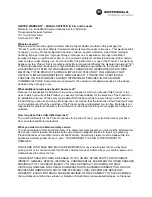
V01.01 |March 2022 | English
3
Figure 8: Locked carabiner on Tweezle O ...................................................................... 6
Figure 9: Optionally clip the other carabiner of the LockD Clips on the Tweezle O ...... 6
Figure 10: Clip the unlocked carabiner of the LockD Clips system onto the Tweezle O 6
Figure 11: Tweezle the unlocked carabiner to lock it on the Tweezle O ....................... 7
Figure 12: Optionally clip the other carabiner of the LockD Clips on the Tweezle O .... 7
Figure 13: Connect shortcut to PPE attachment point .................................................. 7
1.
Brief Description
1.1.
Intended Use
The Tweezle O is an anchor O-ring with an integrated ident mark to lock the securing
system LockD Clips. It is intended to be used as a safe anchor point in fall-prone
situations in ropes courses and other climbing venues, such as with self-retracting
lifelines, rolling elements, Tarzan swings, etc.
To minimize loading on the LockD Clips during a fall, a shortcut connection between
the anchor point and user
’
s PPE can be used.
All other uses are considered improper. The manufacturer
will not be liable for any use other than stated. The
user bears the sole responsibility.
1.2.
Function
The ident mark serves to lock the securing system LockD Clips.
1.3.
Use
Anchor point O-ring for the LockD Clips fall protection equipment and other climbing
securing system.
Risk of serious injury or death - Examine and test before
each use.
2.
Assembly of the Tweezle O
2.1.
Before Installation
Anchoring equipment may only be installed by qualified persons.
Brief user instructions in the shape of a pictogram should be plainly visible where the
Tweezle O is to be used. Ensure that the safety lines, safety devices, and take-off
platforms have sufficient load capacity for their intended use.
Ensure that both children and adults can reach the Tweezle O easily. Install a footstep
to facilitate reach if necessary. Excessive bending or reaching of the LockD Clips to
reach the Tweezle O should be avoided.
Avoid confusing or frustrating users so they are not tempted to trick or manipulate the
system, such as leading users to complicated labyrinths, dead ends, etc.






























